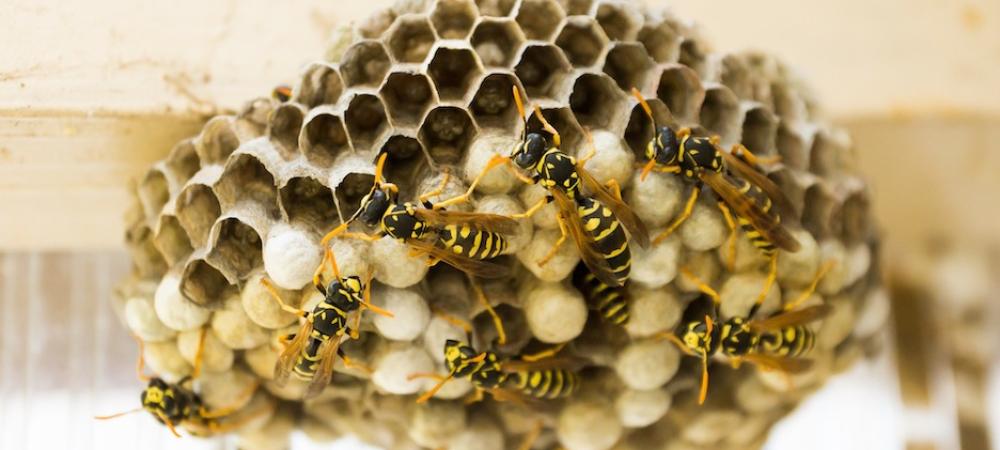Understanding Wasps in North Carolina

If you're a homeowner in North Carolina, you've likely encountered wasps buzzing around your yard at some point. Wasps are a common pest in the state, and while they do help with pollination and pest control, their presence can be dangerous—especially if you're allergic to their sting. Knowing how to identify wasps, prevent infestations, and safely remove them is essential for keeping your home and yard safe.
How to Identify Wasps
Wasps can often be confused with bees due to their similar size and coloring, but they have some distinct features that make them stand out.
- Body Shape: Wasps have a more slender, smooth body compared to bees, which are generally hairier and rounder.
- Color: Most wasps in North Carolina are black and yellow or black and red, giving them a more distinct striped appearance than bees.
- Behavior: Wasps tend to be more aggressive than bees, especially when they feel their nests are threatened. Unlike bees, they can sting multiple times.
You'll most likely spot them hovering near trees, gardens, or even your home if they’ve built a nest nearby.
Why Wasps Love North Carolina
North Carolina's warm and humid climate, particularly during the summer months, provides the perfect environment for wasps to thrive. Areas with lush greenery, such as Raleigh’s expansive parks or Charlotte’s tree-lined neighborhoods, offer plenty of opportunities for wasps to build their nests. Additionally, rural areas like those around the Blue Ridge Mountains are prime spots for ground-nesting wasps, making it important for residents in these regions to be vigilant.
Common Types of Wasps in North Carolina
North Carolina’s warm climate and abundance of greenery make it an ideal home for several species of wasps. Here are a few of the most common types you might encounter:
- Yellow Jackets: These wasps are the most aggressive and can be found in both urban and rural areas throughout North Carolina. They often nest underground, in wall voids, or near homes, making them a frequent problem for homeowners.
- Paper Wasps: Paper wasps build their nests in open, exposed areas like eaves, branches, or porch ceilings. Their nests are easily identified by their umbrella-like shape made from chewed wood fibers.
- Cicada Killers: These wasps are larger and less aggressive than yellow jackets but still intimidating due to their size. They’re most active in mid-summer, and as the name suggests, they prey on cicadas. They typically nest in the ground.
- Bald-Faced Hornets: Known for their large, basketball-sized nests that hang from trees or shrubs, bald-faced hornets are a type of wasp common in wooded areas across North Carolina. Their black-and-white coloring makes them easy to identify.
How to Prevent Wasps Around Your Home
Preventing wasps from building nests on your property is key to avoiding painful stings and potential infestations. Here are some steps North Carolina homeowners can take:
- Seal Entry Points: Inspect your home for any gaps or holes around windows, doors, and eaves. Wasps can squeeze through small openings and establish nests inside walls or attics.
- Remove Food Sources: Wasps are attracted to sweet smells, so be sure to keep outdoor dining areas clean. Cover trash cans tightly and avoid leaving sugary drinks or food out for extended periods.
- Maintain Your Yard: Overgrown shrubbery and wood piles are ideal spots for wasps to build nests. Regularly trim your trees and bushes, and store wood away from your home to reduce nesting opportunities.
- Hang Decoy Nests: Wasps are territorial and often avoid building nests near existing ones. Hanging a decoy nest can help deter them from settling near your home.
- Set Up Wasp Traps: Commercial wasp traps can be effective in catching wasps before they establish a colony. Place these traps away from common gathering areas like patios or decks to lure the insects away from your home.
How to Get Rid of Wasps
If you’ve spotted a wasp nest on your property, it’s important to approach the situation with caution. Wasps will defend their nest aggressively, and their stings can cause allergic reactions in some people. Here's a step-by-step guide on how to get rid of wasps:
1. Identify the Wasp Type and Nest Location
The first step in getting rid of wasps is determining the type you're dealing with and locating their nest. Common wasp types, like yellow jackets, paper wasps, and bald-faced hornets, nest in different areas:
- Ground nests: Typically found in lawns or garden beds (yellow jackets).
- Elevated nests: Often built under eaves, on tree branches, or porch ceilings (paper wasps or bald-faced hornets).
Once you know the nest type and location, you can choose the appropriate removal method.
2. Wear Protective Clothing
Wasps become aggressive when they feel their nest is threatened, so wear protective clothing before approaching the nest. Long sleeves, pants, gloves, and a hat with netting (or something to cover your face) can reduce the risk of being stung.
3. Choose the Right Time
The best time to remove a wasp nest is in the evening or early morning when wasps are less active and inside the nest. At this time, you’re less likely to disturb them, minimizing the chances of an aggressive attack.
4. Use a Wasp Spray
Wasp sprays are designed to reach nests from a safe distance, often up to 20 feet. Here’s how to use it effectively:
- Stand as far back as possible and aim directly at the nest’s entrance.
- Saturate the nest with the spray, ensuring that it reaches deep inside.
- After spraying, retreat to a safe distance and wait a day or two for the wasps to die.
5. Remove the Nest
Once you’re certain the wasps are no longer alive, carefully knock down the nest using a long tool, such as a broom handle. If it’s a ground nest, cover the hole with soil or a heavy object to ensure no surviving wasps can rebuild.
6. Consider Non-Chemical Methods
For those looking for natural solutions, here are a couple of alternatives:
- Soap and Water: A mixture of dish soap and water (2 tablespoons of soap per 1 cup of water) can be an effective wasp killer. Spray the solution directly on the nest, which clogs the wasps' breathing pores.
- Homemade Wasp Traps: Place a sugar-water solution or meat inside a bottle to lure and trap wasps. Set these traps away from high-traffic areas to reduce encounters.
7. Call a Professional
If the nest is large, located in a difficult-to-reach spot, or you're allergic to wasp stings, it’s best to hire a local pest control professional. Our team of trained pest control exterminators can safely and effectively remove the nest without putting you at risk. Contact us today to get started!



